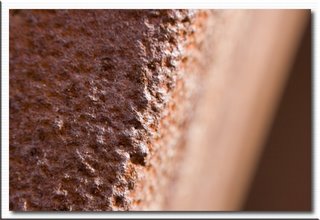
Rust is the substance formed when iron compounds corrode in the presence of oxygen and water. It is a mixture of iron oxides and hydroxides. Rusting is a common term for corrosion, and usually corrosion of steel.
Iron is found naturally in the ore haematite as iron oxide, and metallic iron tends to return to a similar state when exposed to air, (hydrogen, oxygen, nitrogen, etc.) and water. This corrosion is due to the oxidation reaction when iron metal returns to an energetically favourable state. Energy is given off when rust forms. The process of rusting can be summarized as three basic stages: The formation of iron(II) ions from the metal; the formation of hydroxide ions; and their reaction together, with the addition of oxygen, to create rust.
Iron is the main component of steel and the corrosion of steel is observed more frequently, since iron is rarely used without alloying in the present day.
Hence, rust is iron(III)oxide, which is formed by the dehydration of iron(II) hydroxide. Corrosion tends to progress faster in seawater than fresh water due to higher concentration of sodium chloride ions, making the solution more conductive. Rusting is also accelerated in the presence of acids, but inhibited by alkalis. Rust can often be removed through electrolysis, however the base metal object can not be restored through this method.
Galvanization consists of coating metal with a thin layer of another such metal. Typically, zinc is applied by either hot-dip galvanizing or electroplating. Zinc is traditionally used because it is cheap, easy to refine and adheres well to steel. Zinc also provides cathodic protection to metal that itself is unplated, but close enough that any water touching bare iron is also in contact with some zinc. The zinc layer acts as a galvanic anode rusting in preference. Galvanization often fails at seams, holes and joints, where the coating is pierced. More modern coatings add aluminium to the coating as zinc-alume, aluminium will migrate to cover scratches and thus provide protection for longer. These rely on the aluminium and zinc oxides protecting the once-scratched surface rather than oxiding as a sacrificial anode.
There are several other methods available to control corrosion and prevent the formation of rust, colloquially termed rustproofing. Cathodic protection makes the iron a cathode in a battery formed whenever water contacts the iron and also a sacrificial anode made from something with a more negative electrode potential, commonly zinc or magnesium. The electrode itself doesn't react in water, but only to provide electrons to prevent the iron rusting.
Bluing is a technique that can provide limited resistance to rusting for small steel items, such as firearms; for it to be successful, water-displacing oil must always be rubbed onto the blued steel.
(courtesy wikipedia.com)




No comments:
Post a Comment